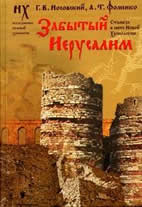 Publishing house: AST (ASTREL) Moscow, 2008.
Publishing house: AST (ASTREL) Moscow, 2008.
CONTENTS
Chapter 1. Istanbul
1. When and by whom the Church of Hagia Sophia in Istanbul was built
2. Why it is considered today that a painter of the XV century "in a wrong way" expressed the siege of Tsar-Grad by the Turks
2.1. The Church of Hagia Sophia on a drawing of the XV century
2.2. The Kazan dragon on the flag of Osmans-Atamans on a drawing of the XV century
2.3. St. George on the black flag of Osmans-Atamans, laying siege to Tsar-Grad
2.4. Boats on the wheels. Russian prince Oleg and Osman-Ataman Mohammed II
3. The Big Church of Hagia Sophia in Tsar-Grad – the Church of Solomon
3.1. The Big Church of Hagia Sophia, the Small Church of Hagia Sophia and the Church of St. Irene
3.2. Why there are no traces of shrinkage of the Big Sophia
3.3. The Big Sophia as the first experience of Cyclopean construction of Osmans-Atamans
3.4. A legend about gems
3.5. Why a synodal translation of the Bible renames an altar into debir and kiot into reliquary?
3.6. Why a synodal translation of the Bible hides that the Church of Solomon was built of bricks?
3.7. The scaffolds around the Church of Solomon
3.8. Stone cutters or woodcutters worked at the construction of the Church of Solomon?
3.9. Turkish sultans of the XV-XVII centuries prayed in the Church of Hagia Sophia among golden icons
3.10. Who from the Osman sultans decorated the Hagia Sophia and with what
3.11. Why the Big Sophia was used as a tsar shrine only in the sixteenth century, at the time of sultans
3.12. Roxolana
3.13. Foggy memories about the Christian church, which was actually built by Suleiman
3.14. What for the signatures on the arcs of the Big Sophia were overthrown and displaced?
4. The Church of St. Irene
5. The size of the Biblical Church of Solomon compared to the size of the Churches of Small Sophia and Big Sophia in Tsar-Grad
6. A high construction in front of the Biblical Church of Solomon and a minaret in front of the Hagia Sophia
7. Mysterious "much water in the center of the pillar of David" in Jerusalem – these are huge underground reservoirs-tanks of medieval Istanbul
8. "The sea of the Church of Solomon in Jerusalem" on the twelve waves – these are reservoirs-tanks in Istanbul
9. About one ancient accident in the water tanks of Jerusalem during the snowy winter
10. The palace of sultans Topkapi on the place of the former Blachernai Palace in Istanbul
11. A mosque-church of Mohammed the Conqueror
12. An obelisk of Thothmes III
13. The burnt column of Konstantin
14. Suleiman the Glorious and Biblical Solomon - poets, singers of love
15. The Church of St. Irene – one of the first churches- basilicas of the apostolic Christianity, which replaced the former churches-circuses of the family Christianity
Chapter 2. CALVARY
1. The mountain Calvary under evangelic Jerusalem – it is the mountain Beykoz under Istanbul
2. New Jerusalem under Moscow reproduces the plan of "the tomb of Jesus" on Beykoz
Chapter 3. LOST BY HISTORIANS AND FOUND BY US JERUSALEM
1. Where evangelic Jerusalem is placed?
2. Jerusalem – it is the old fortress Eros on the Asian bank of Bosporus, near the influx of Bosporus into the Black sea, near the mountain Beykoz
3. A year of construction of the fortress walls of Eros - 1261 A.D. coincides with the year of capture of Tsar-Grad by the Niceans
4. A distance from Eros- Jerusalem to the peak of Beykoz-Calvary – around two hours on foot, - well agrees with the Gospels
5. Christian symbols on the towers of �ros- Jerusalem
6. Comparison of the placement of Eros-Jerusalem and Istanbul-Constantinople. Constantinople is a later capital
Chapter 4. OUR RECONSTRUCTION
1. Russia and Horde
1.1. Different points of view
1.2. A short wording of our reconstruction
2. Who were Mongols-tartars
2.1. From whom the Mongol troops were composed
2.2. If there were many Mongols? Mongols in the eyes of the coevals. What Mongols and Russians wore
3. "The Tartar-Mongol conquest" and the Orthodox Church
4. Cossacks and Horde
4.1. The Cossacks – these were permanently acting troops of Russia-Horde
4.2. Why Moscow governors entered a war not "with troops", but "with tartars". Polish-Lithuanian tartars
5. So, what is the Horde?
6. About the conquest of Siberia
7. Tartar and Russian names in Russia
7.1. Tartar names like nicknames
7.2. "A strange" influence of the Mongol conquest on the Russian culture
7.3. Russian and Tartar names on example of the family tree of Verderevskiys
8. What is the Mongol language?
8.1. If many Mongol texts remained?
8.2. In which language the famous khan yarlyks were written?
8.3. About Russian and "Tartar" letters
8.4. When the history of Mongols was written
9. Gog and Magog, prince Ros, prince Meshekha and Tubala. Russia-Horde and Moscow Russia on the pages of the Bible
Chapter 5. RUSSIA AND TURKEY
1. Abdul-Feda: "Russes –people of the Turkish nationality"
2. Russia and Turkey
3. Written with Russian letters writings of Turkish janissaries
4. Amazons in Russia in the XVII century. A purdah on the face of Russian women
5. Arabic signatures on the old Russian arms
6. The Arabic conquest from the point of our reconstruction
7. An Arabic signature on the episcopal mitre, a contribution of the princes Mstislavskiys in the Troitse-Sergiyeva Lavra
8. "Walking to three seas" of Afanasiy Nikitin
9. Janissaries
Chapter 6. HOW THE GREAT RUSSIAN EMPIRE WAS ESTABLISHED. FALSIFICATION OF HISTORY IN THE XVII-XVIII CENTURIES
APPENDIX. "DESCRIPTION OF THE COURT OF CAESAR OF TURKEY" 1649 IN TRANSLATION OF ANDREY LYZLOV (file *doc 354 kb)
LITERATURE.